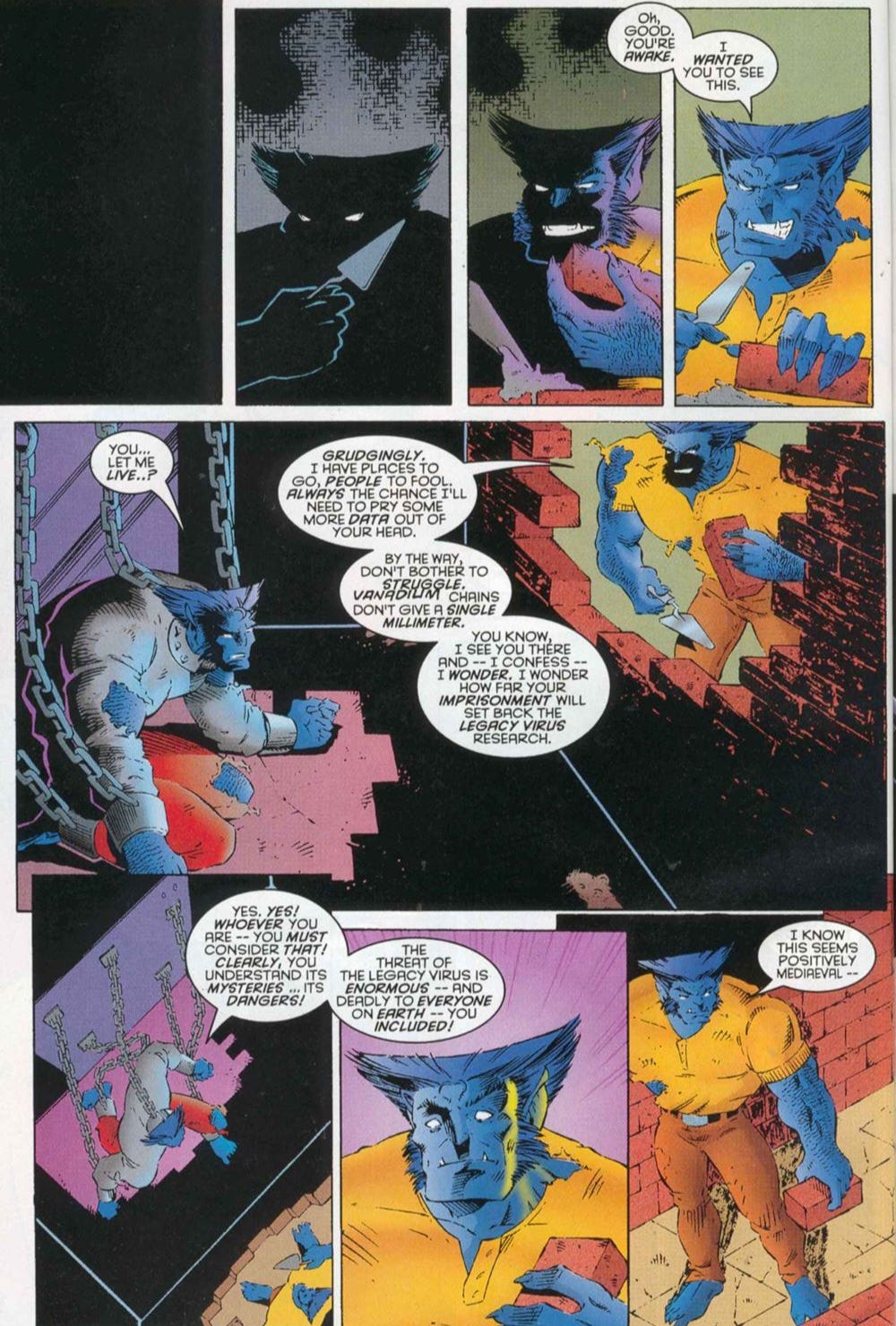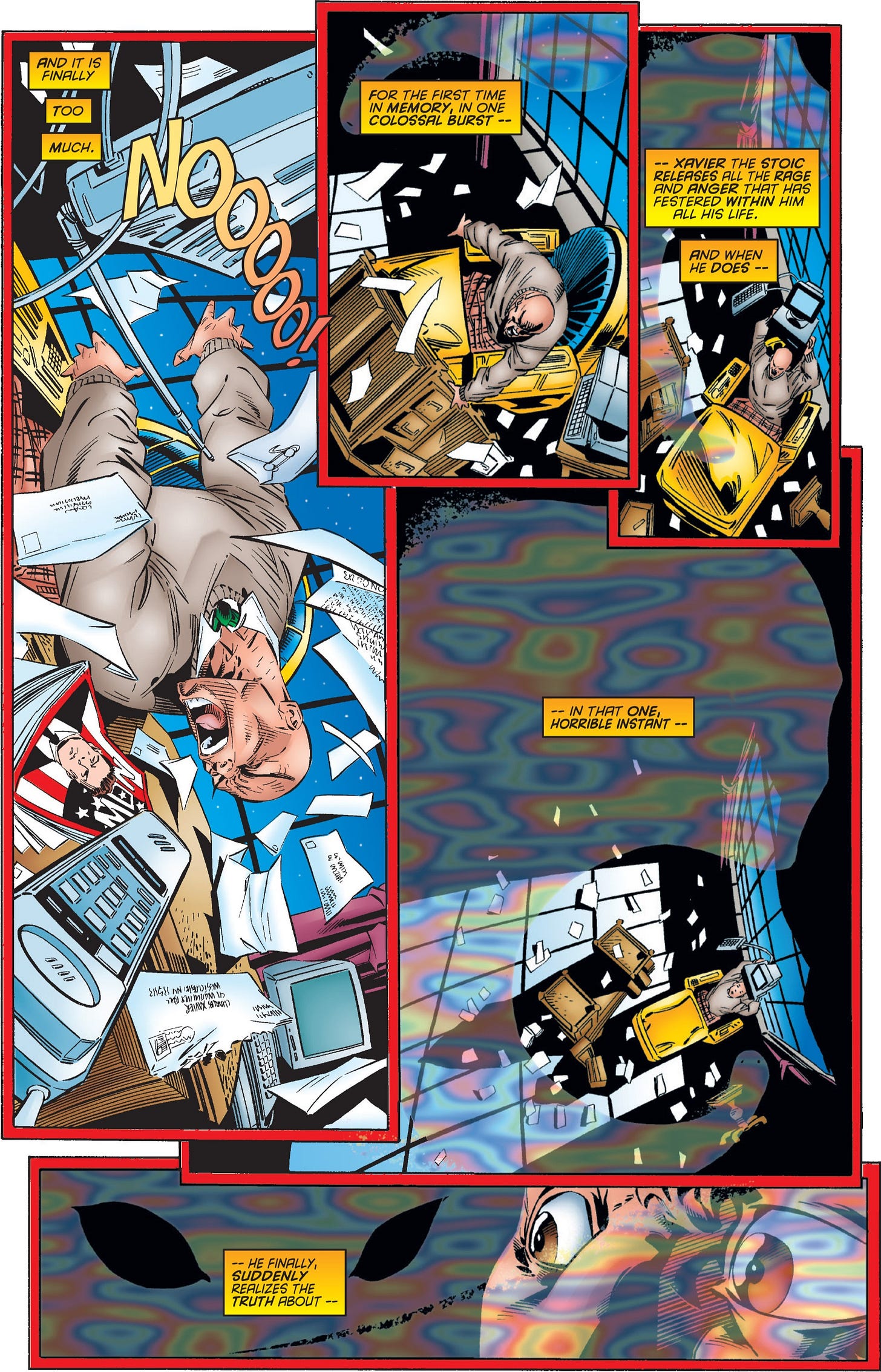“Road to Onslaught” and “Prelude to Onslaught” really only have meaning insofar as which issues Marvel put into each collection. As noted in the Introduction, there are hints going as far back as 10 months before Onslaught appeared. Most of those are vague hints at best, adding nothing to the story. For the purposes of this retrospective, I’m beginning the Prologue at X-Men Unlimited 10 and X-Men 50—the latter of which was the first issue that saw both significant interaction with Onslaught (though that was unknown at the time) and conflict with Onslaught’s forces. It is also, unfortunately, where we see the first sign of the event’s most fatal flaw: at no point did the writers seem to know what Onslaught was or what he wanted.
The Prologue consists of the following issues (listed as close to a suggested reading order as possible). Some have only minor significance.
Opening Salvos
X-Men 50 sees some X-Men spirited off to be evaluated by a servant of Onslaught. Since Onslaught is Xavier and has access to his knowledge and abilities he has no reason to test the X-Men. Meanwhile, the rest of the team (Xavier included) are interacting with an unspecified psionic entity. Xavier speaks directly to it. This entity will be seen again, and again it will be separate from Xavier–so separate in fact that right before Onslaught is revealed to be Xavier it coalesces and takes shape around his body.
But just before this confrontation, McCoy (the Dark Beast from Age of Apocalypse who escaped to the prime universe) launches a plan to replace prime Beast. His concerns are twofold: he’s worried that Mr. Sinister will learn about his presence after he meddled with Sinister’s schemes years earlier (after Age of Apocalypse it was retconned that McCoy created the Morlocks), and he also wants to keep an eye on Bishop who has fragmented memories of the Age of Apocalypse. McCoy replaces Beast in X-Men Unlimited 10, and while this doesn’t have a significant impact on the event, it is a subplot that runs through it.
The next several issues in the prologue add little to the story. X-Men 51-52 remind the reader that since his arrival in the present Bishop has been hunting a traitor who will destroy the X-Men. Uncanny X-Men 333 spends most of its time setting up Operation: Zero Tolerance (which won’t start for another year). The issue does reveal that the government is aware of something called Onslaught (this goes nowhere) and that something mysterious happened at a sentinel plant. In the closing pages the unidentified entity from X-Men 50 aids the X-Men’s escape from the government facility they had infiltrated.
Elsewhere, as all of this is going on, Rogue meets up with Joseph (implied to be a revitalized Magneto with amnesia but who will eventually be exposed as a clone). The two head off together in search of the X-Men (who Joseph has been searching for since Uncanny X-Men 327), neither one knowing about what’s building back home.
The Villain Makes His Move
The first real hints of who Onslaught is come in X-Man 15-17 when Onslaught recruits Holocaust (another refugee from Age of Apocalypse) to capture Nate Grey, and in Cable 33 when Cable fights another of Onslaught’s servants. In X-Man, during the fight, Holocaust indirectly reveals that he knows who Onslaught is and that his identity won’t surprise Nate. This ties into a plot thread running through the X-Man books since Nate’s own arrival in the prime universe: his distrust of Xavier. The two fought in X-Man 10 where Nate pulled Xavier out of the astral plane, making him corporeal. Onslaught also appears in shadow in this issue and he does not match his later appearances. Over in Cable, while the Nate/Holocaust fight is happening elsewhere, Cable deduces Onslaught’s identity but passes out before he can tell anyone.
In his first direct move against the X-Men, Onslaught psychically kidnaps Jean Grey and proceeds to argue that Xavier's dream is flawed and doomed to failure because those fighting for it are hypocrites. He tries to back up his claims by showing Jean parts of Xavier's dark side. This feels like a strategy in contradiction to Onslaught's goal, though. His intention is to convince Jean to join him and to do this he reveals Xavier’s dark side to Jean. But Onslaught is Xavier and knows that he’s Xavier so his strategy is in direct contradiction to his goal: he’s driving Jean from Xavier rather than toward him.
Roughly concurrent to those events, the Fantastic Four go off to space, leaving Franklin at home where he spends time with an imaginary friend named Charlie who is actually an Onslaught psionic projection intended to manipulate Franklin. At approximately the same time as this, or slightly later, Nate Grey--who left in search of the Avengers at the end of X-Man 17--arrives in Avengers mansion and tells them that Charles Xavier has gone insane. No reason is given for how Nate acquired this knowledge. The best possible explanation is that he somehow psychically became aware of Onslaught's actions between X-Men 53 and Onslaught X-Men.
Fast forward to the prologue’s final two issues. Juggernaut has traveled to the X Mansion so Jean Grey can read his mind and reveal Onslaught’s identity which he insists is locked inside.
Early Contradictions
While Jean is running around with Juggernaut, Xavier has two separate encounters with Cannonball and Cyclops and is an absolute jerk to both. However, at the end of his encounter with Scott, his personality abruptly changes to someone apologetic and afraid. Later, in a second Cyclops encounter, Xavier realizes he opened his files on Franklin Richards (who he began psychically talking to in Fantastic Four 414) but doesn’t remember doing so. The implication is that Onslaught exists within Xavier’s body like a separate personality and can take control of him.
In the final pages of X-Men 54, the psychic energy we first saw in X-Men 50 coalesces around Xavier’s body to create Onslaught’s armor. If we accept that Onslaught and Xavier are distinct entities within one body, if follows that while Xavier is in control of his body Onslaught can project himself outside Xavier’s body in a form that Xavier himself can interact with (the psionic entity in X-Men 50), as well as manifest his physical armored exterior around Xavier’s body (as seen in X-Man 16 and Excalibur 99).
As for those final pages—Uncanny X-Men 334 and X-Men 54, the issues that finally reveal Onslaught's identity—they shine a spotlight on major continuity problems with the villain’s setup. And it all revolves around Juggernaut.
It’s eventually established that at this point in his evolution (prior to Onslaught X-Men—after which things get murky), Onslaught is physically tied to Xavier so Xavier has to be present for Onslaught to exert any physical power. Further, Onslaught only has access to his extreme strength when his armor has manifested.
Complicating this is the fact that Xavier is seen in the mansion in X-Men 42-43, published at the same time as Uncanny X-Men 322 where Juggernaut got punched from Canada. And while simultaneous publication does not necessarily mean simultaneous occurrence, the storylines running in both series make it very tough to square Xavier getting to Canada and back with a detour to find Juggernaut and clobber him along the way.
But for the sake of argument, let’s assume Xavier made that trip. It’s hinted in these prologue issues, and confirmed later, that Onslaught only learned to exist as a physical entity because of Xavier’s interaction with Nate Grey. That encounter wasn’t seen until five months after Juggernaut’s encounter with Onslaught, and continuity in both series makes it clear that what happened to Juggernaut happened first.
It’s ironic that of all the issues I count among the prologue, the issues that are heaviest with Onslaught content are also the most flawed. We know Scott Lobdell had no plan for who or what Onslaught was at the time Juggernaut fatefully utter his name. Unfortunately, reverse engineering Onslaught to be Xavier makes the events of Uncanny X-Men 322 run counter to everything that came after it. I have no doubt that major characters and events are reverse engineered on occasion, but it did not work well here. By the time the prologue ends and the event begins in full in Onslaught: X-Men, the story problems that will grow more substantial as the event goes on are already clear. The Onslaught-lite issues, though, are decent. Some of them are even quite good with interesting character arcs (especially the Cable and X-Men Unlimited issues). Also, the final two issues leading to Onslaught’s reveal are very tight with tension ratcheting up on every page as action is interspersed with some frankly disturbing Xavier interactions. The excitement of the ending covers up the problems, making the prologue work on a first read and raising expectations that will prove too high for the upcoming event to meet.
<— Previous: Introduction
If you were reading Marvel comics in the mid-nineties there was no escaping the expansive, multi-title events that seemed to get bigger and more EXTREME (because everything in mid to late nineties comics was EXTREME) as time went on…
Next: Onslaught Phase 1 —>
Onslaught is not a well organized event. It’s not linear, moving from one part to another. Nor is it organized around a central series augmented by optional tie-ins…
Check out the Introduction for an index of posts. For issue-by-issue commentary of every issue, visit my Twitter @theronscomics #MarvelOnslaught.
Thanks For Reading!
I love making comic book content, but it takes a lot of time. If you’re so inclined, donations make a big difference. And thanks to everyone who has chipped in!
Did you enjoy the post? Feel free to share it!
Want to add to the discussion? Drop a comment! Want reviews and other content straight to your inbox?
If you like my comic content and are into video games, I do walkthroughs with detailed story analysis at Bookishly Gaming.
Find my content all over the internet.
Credits












